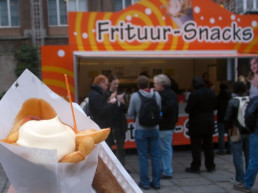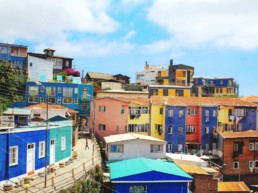Being based in Vietnam for over six months, I finally made the trip to the central Vietnamese city of Hoi An. I absolutely regret not coming to this UNESCO World Heritage site sooner. One of the primary reasons why I, along with many other travellers, fell in love with the ancient town and nearby rice paddies is the incredible Hoi An food scene. Local Vietnamese food varies by region and without question the famed Banh Mi sandwich, Vietnamese coffee, and various noodle dishes take drastically different forms from North to South. So while you may have already enjoyed your share of Vietnamese food, you certainly haven’t had it like this before. With several cooking classes, locally revered restaurants (just ask Anthony Bourdain), and exciting food tours from the likes of Vespa Adventures, Hoi An is without a doubt a foodie’s paradise.
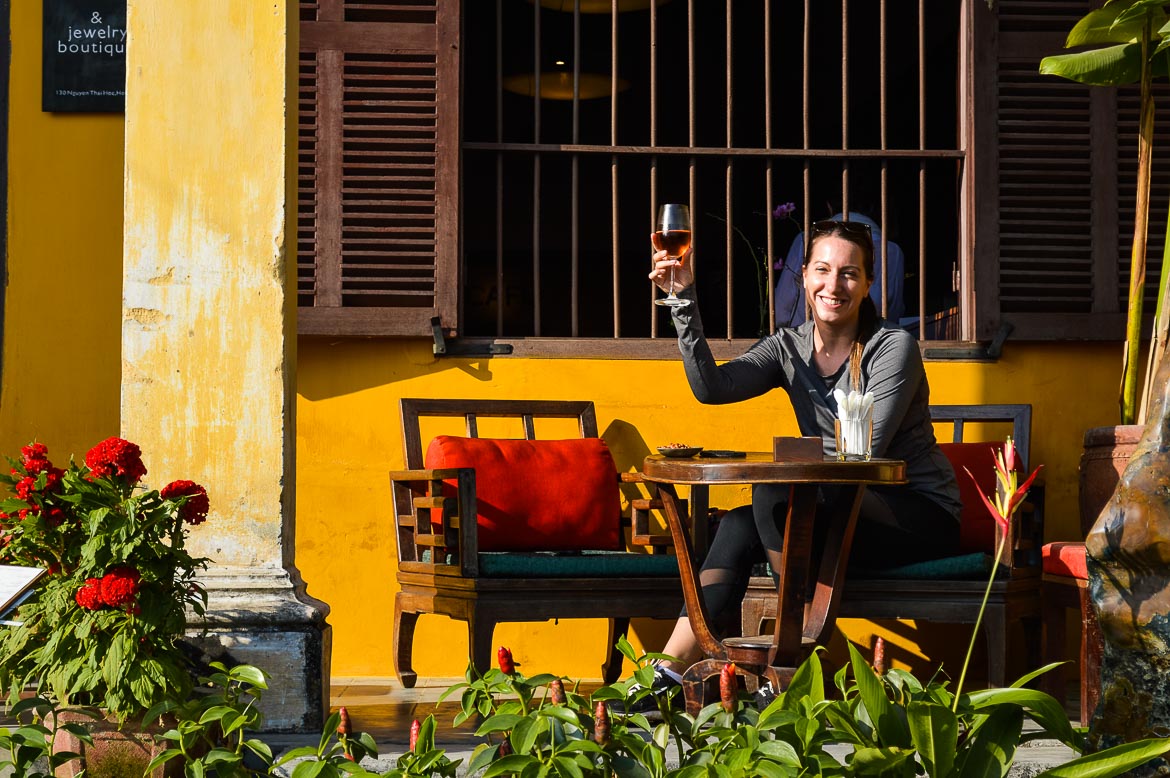
I was also exploring Hoi An as a solo traveller, meaning covering a lot of ground and ordering tons of different dishes can be at times challenging and costly. And it’s no secret that the Departful team enjoys a good beer or two along with our meals. So the idea of joining a Vespa Adventures Streets and Eats Night Tour made sense. Unlimited alcoholic drinks, friendly guides to drive you around all evening, and an introduction to over five amazing restaurants and food stalls that you would never come across on your own. Perfect. Indeed the night was one of the most memorable food and travel experiences I’ve had in all of my time in Vietnam.
If you’re headed to Hoi An, prepare yourself for a world of delicious local food. Many of my top picks were discovered on the Vespa Adventures tour. Here’s a rundown of what awaits hungry travellers as they eat their way through Hoi An.
Hoi An Food Specialties
Bánh Căn Trứng Cút
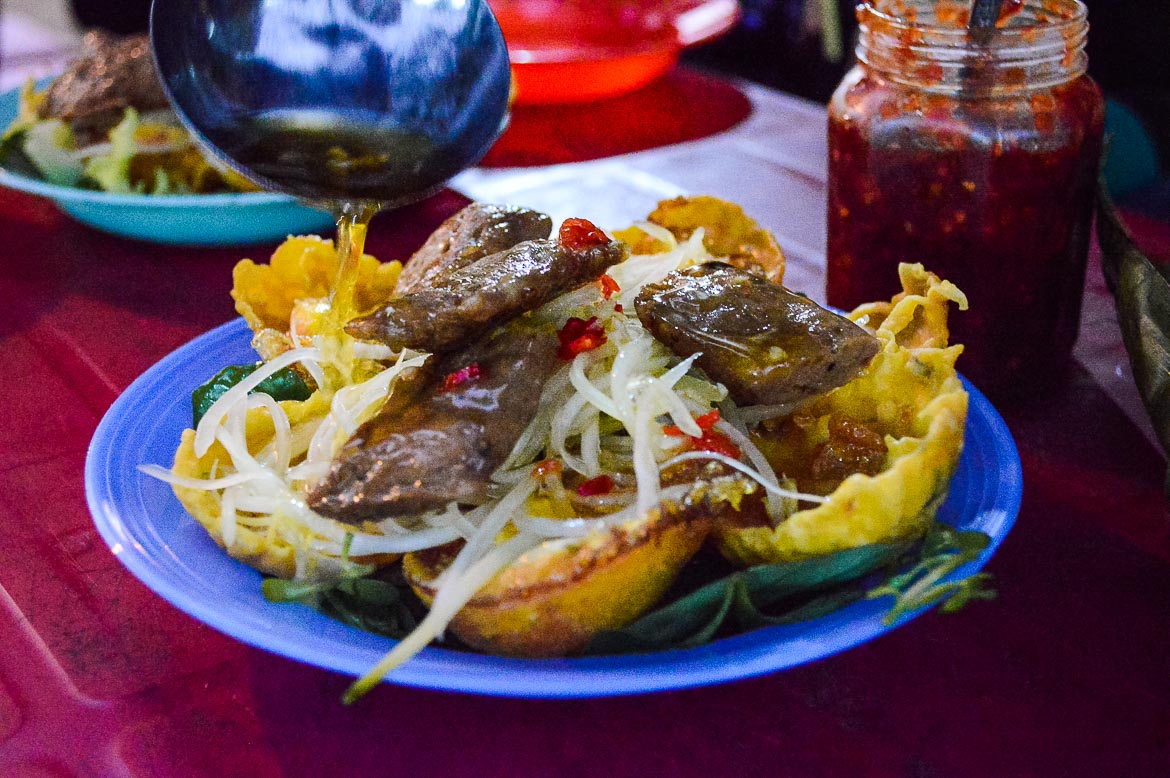
You’ll find some of the best dishes dining street side in Hoi An, on low plastic chairs set up down little alleyways. The first stop on our tour was a simple ‘open air’ dining operation by a woman who only closes two days a month for observance of new and full moons. What she lacks in overhead she more than makes up for in the amazing flavour of Bánh Căn Trứng Cút. The dish is made of rice flour and turmeric pancakes that are cooked above an open flame. The pancakes are filled with egg, then served with pork sausage, grated papaya salad, assorted herbs, and a healthy dose of fish sauce ladled over top. It’s nothing short of pure magic no matter what your pallet. The eatery (for lack of a better term) is beside Zoom Cafe at 134 Tran Cao Van St. Zoom, by the way, happens to serve up some of the best mixed drinks in town for those interested in a break from bia hoi (the cheap, light local draft beer).
White Rose Dumplings
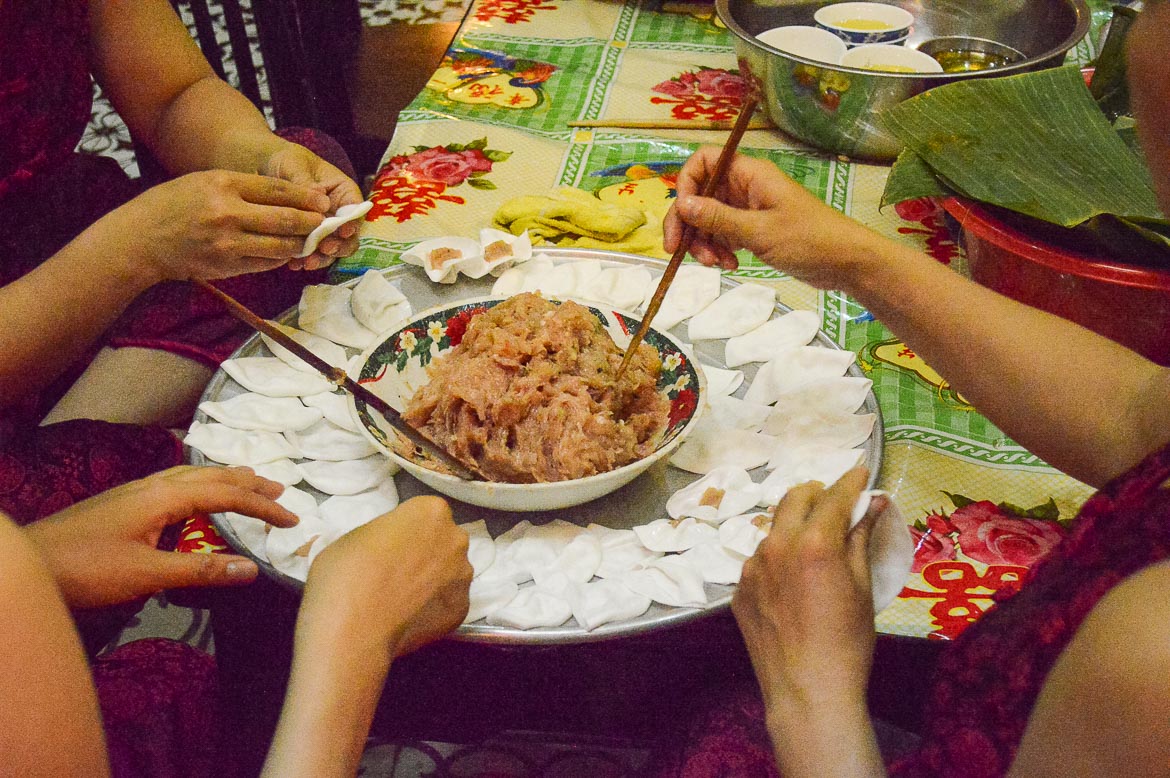
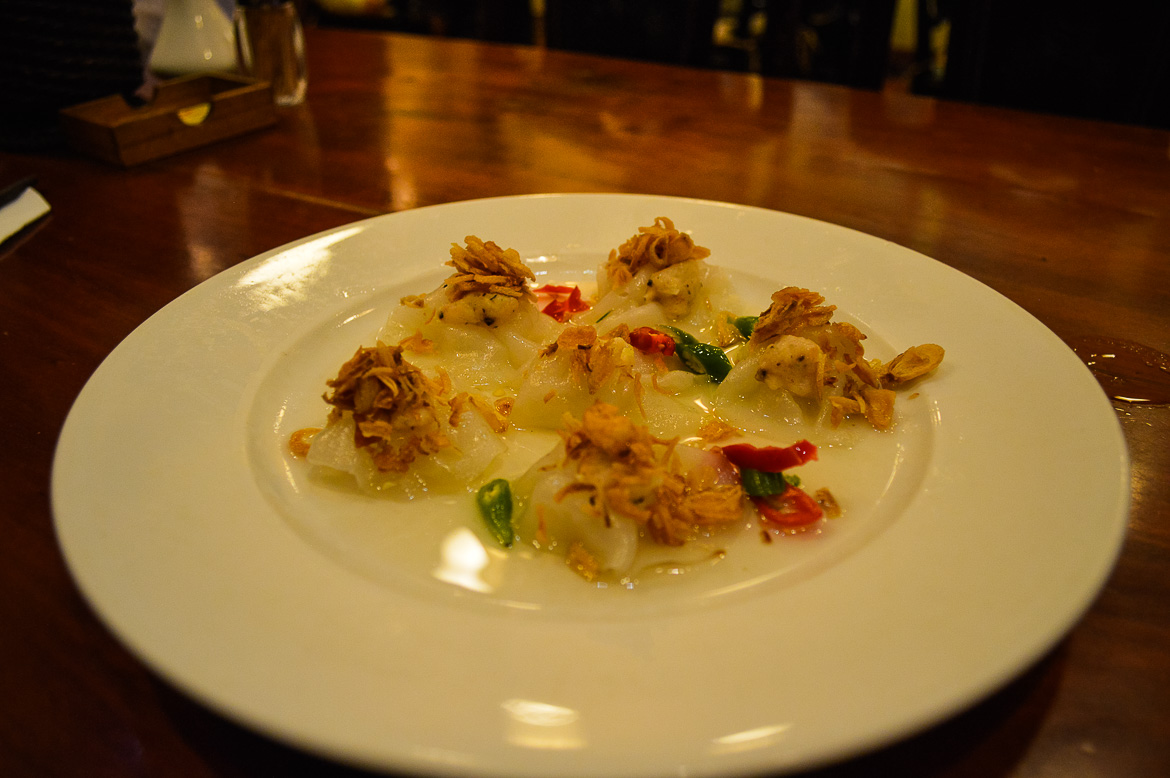
White Rose dumplings are a local specialty within the Hoi An food scene. In fact, only one operation, the White Rose Restaurant, produces these tasty morsels and supplies all other restaurants in the region. A talented team of women make 4,000-5,000 each day. During the Vespa Adventures tour I was given the chance to make my own, and let’s just say I’m sticking to my day job. The dumplings, shaped like white flowers, are gently made from rice dough with shrimp paste inserted into the middle, producing a flower like masterpiece. Steamed then served along side fish sauce with chilli peppers and topped with fried shallots or onions, the dish is worth its weight in gold.
While the White Rose Restaurant certainly offers the freshest dumplings in town, I’m also a big fan of the White Rose dish served at Miss Ly’s Cafe. Both are notable family run institutions and generate long queues during dinner time that are well worth the wait. Miss Ly’s is located more centrally in the old town, at 22 Nguyen Hue St.
Street Meat & Sweets
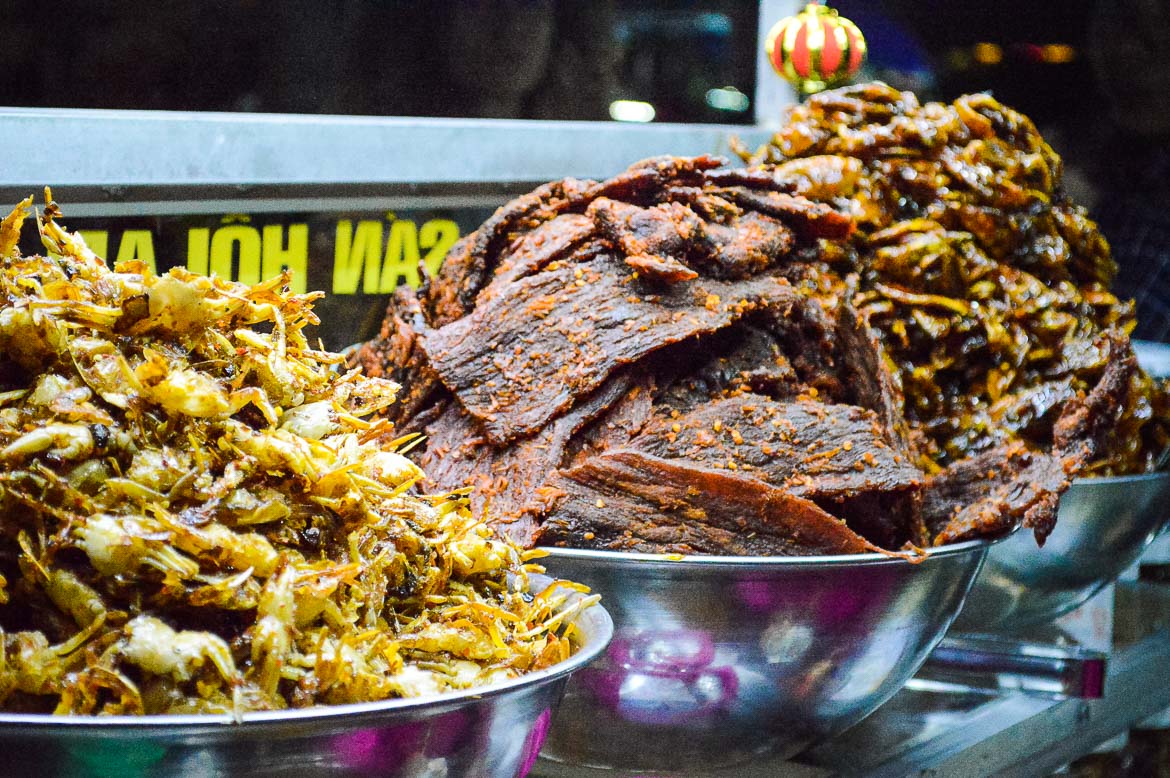
Hoi An’s night market branches out south from the Thu Bon River along Nguyen Hoang Street. In addition to its famed lanterns, the nightly market is home to some delicious ‘street meat’ options – and no we’re not talking hot dogs. Dried fish, beef, tiny crabs, and beetles to name a few. For those with a slightly more sensitive stomach, the beef is a delicious marriage of jerky and dry chilli rub. Have a sweet tooth? There are numerous vendors whipping up deep fried fritters and doughnuts of seemingly endless variation of what’s inside or on top. Banana, dried coconut flakes, sesame seed, palm sugar, icing sugar. Check, check, check.
Bánh Tráng Nướng
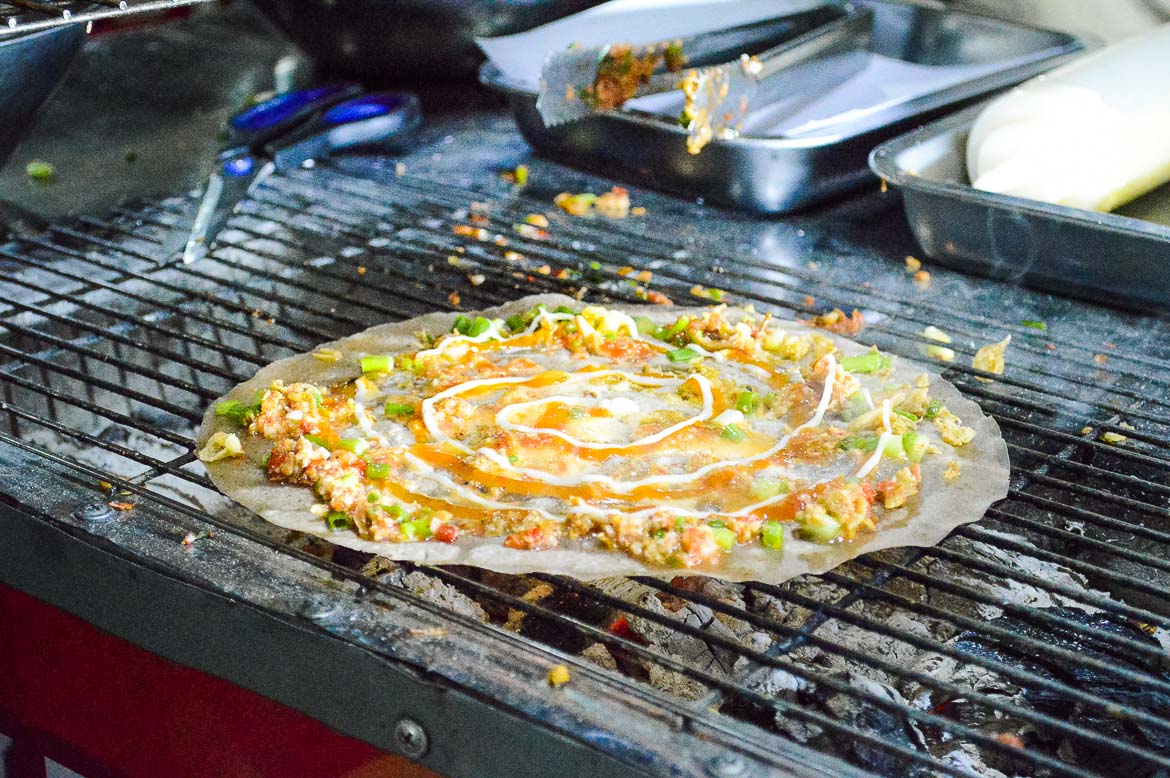
It’s pizza. It’s seafood. It’s a giant crispy rice cracker. It’s all of the above, and it’s mighty tasty. Bánh Tráng Nướng (Vietnamese Pizza) is available hot off the grill along the night market road and makes for a great snack. Truth be told, this dish is served throughout Vietnam. Both Da Lat and Hoi An claim to be the originators, though variation across the country pertains to size and toppings. Expect your choice of seafood, pulled chicken, pork or beef floss, or partially cooked quail egg, served with cheese, chilli sauce, green onions, and garlic ingredients. Expect to pay 40k VND or less for one.
Cau Lầu
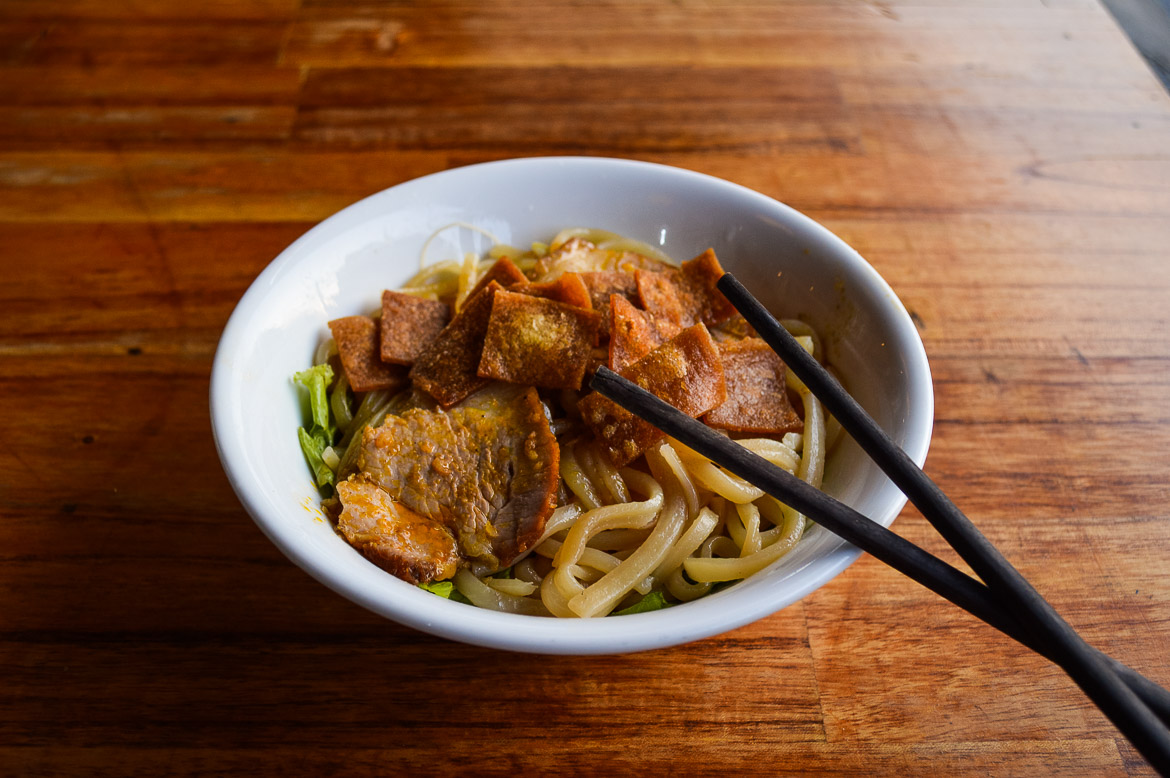
Though not a stop on the tour, a journey through the Hoi An food scene isn’t complete without at least a few servings of the region’s specialty dish, Cao Lầu. It’s simple comfort food through and through. The ingredient list sounds fairly simple: cao lầu noodles, slices of barbecue pork, bean sprouts, mixture of lettuce and herbs, topped with pork crackling (or commonly substituted for dried cao lau noodle chips), then finished with a small amount of stock. The magic comes from the thick cut rice noodles themselves, and the effort that goes into making them. The water used to make the noodles comes from ancient wells around Hoi An, the most famous of which being Ba Le Well, and is mixed with ash from trees found on nearby Cù Lao Chàm Island. The result is a distinctive yellow colour and firm texture of the noodles. Turmeric is sometimes added to ensure the yellow colour. I thoroughly enjoyed my servings at various road side stalls as well as the higher-end offering at the aforementioned Miss Ly’s Cafe.
Thịt Nướng
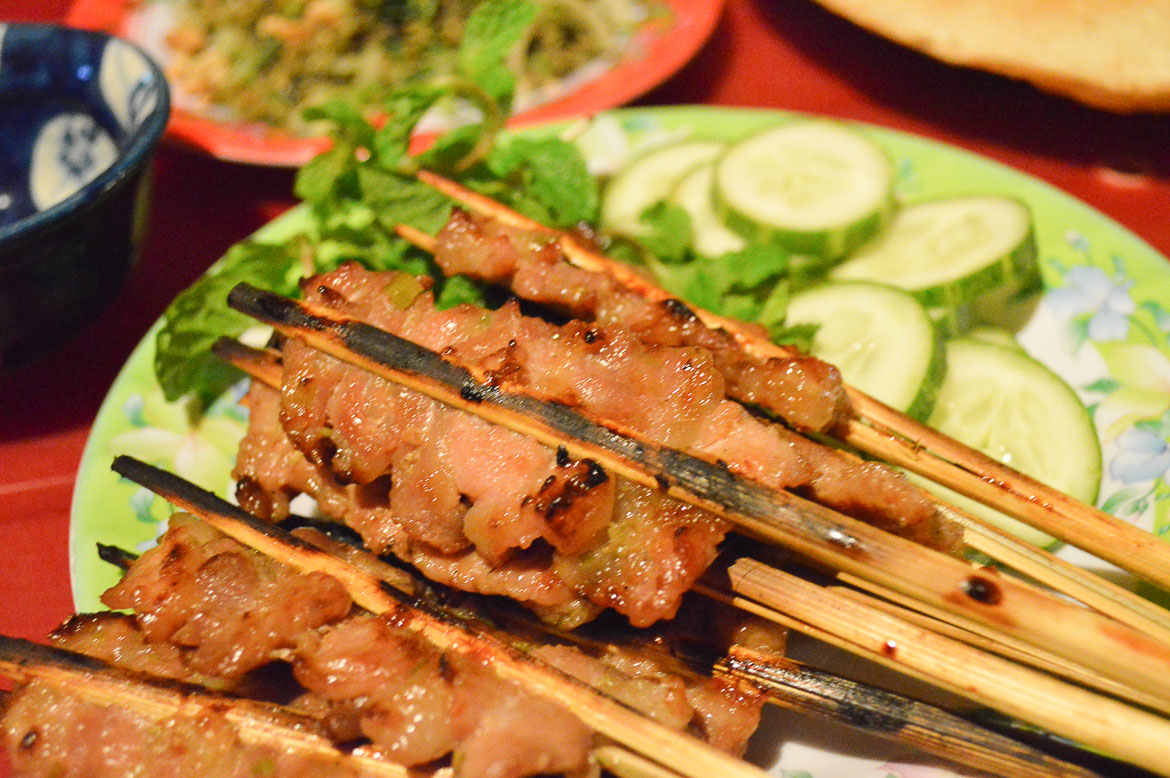
The affinity for Thịt Nướng (grilled pork) in Hoi An is unquestioned. As is the unique serving style, with marinated pork pieces being cooked over hot coals while resting amid split bamboo chopsticks – de facto skewers, if you will. Often served alongside mint, mixed herbs, and cucumber and dipped into a fish sauce vinaigrette, thịt nướng is delicious. Best enjoyed from the plentiful small street side stalls.
Hot Pot
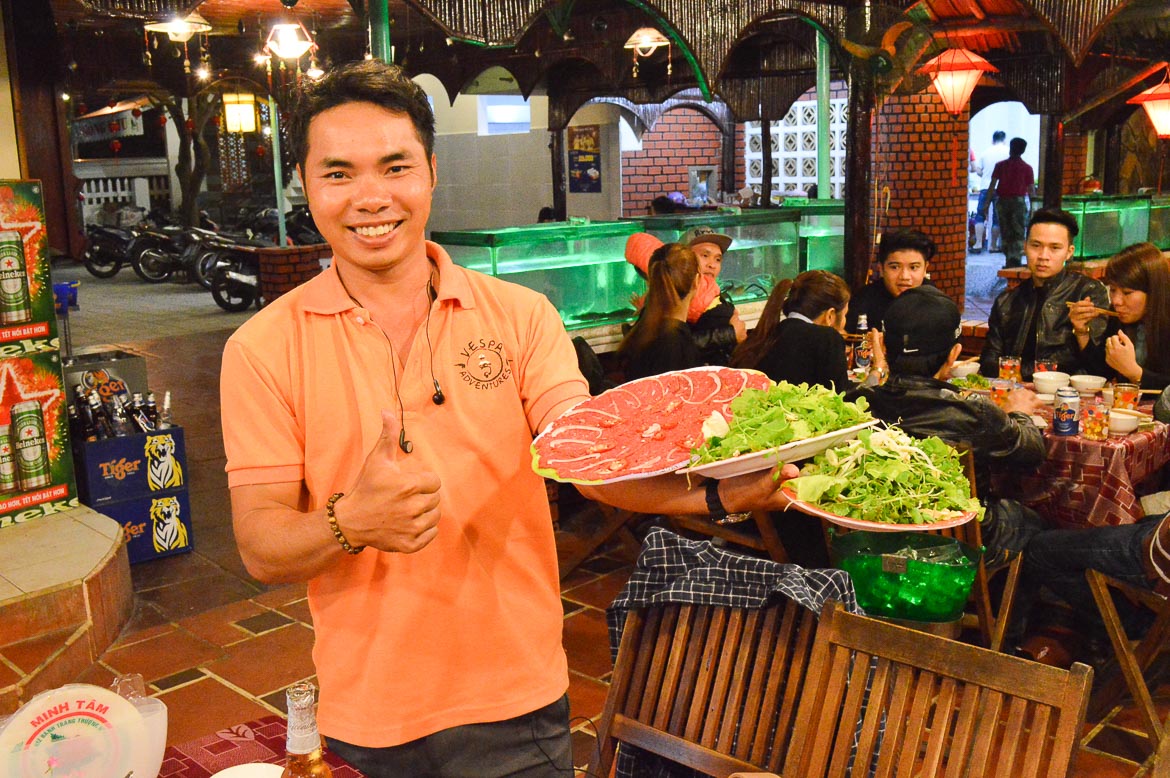
In addition to a DIY venison and okara dish chargrilled table side, one of the focal points of the Vespa Adventures’ Hoi An food tour is certainly the Vietnamese hot pot at Sông Thu. Thin slices of beef are cooked communally in a hot pot full of various secret herbs and spices. Once ready, guests are encouraged to prepare their own fresh spring rolls with rice paper and the abundance of mixed herbs, lettuce, and hot peppers on display in front of them. If you hadn’t guessed it by now, the spring rolls are dipped into a fish sauce vinaigrette. The sauce, by the way, is a basic staple for many Vietnamese dishes (as you can likely tell from the numerous references made in this article alone). It’s made of fish sauce, water, sugar, lime juice, minced garlic, and chilies. It’s so good it’s capable of prompting some travellers to chug the delicious nectar at the end of a meal.
Bánh Xèo
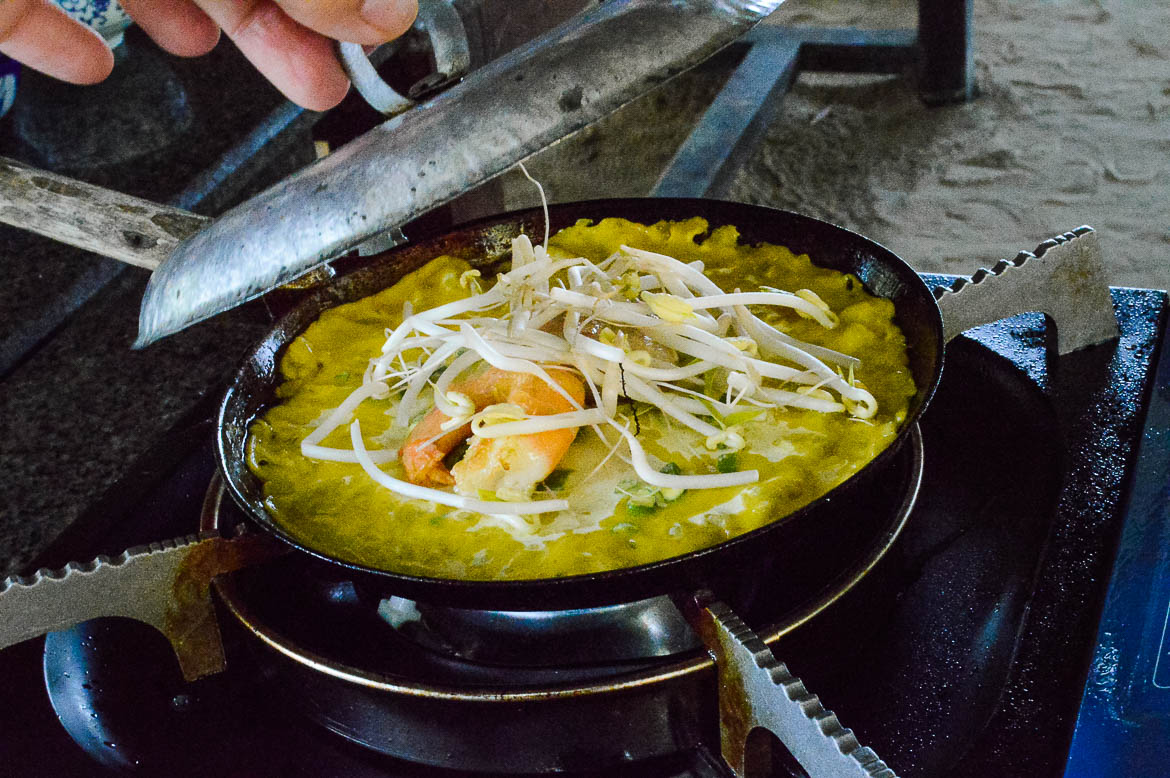
Bánh Xèo are crispy pancakes that are served in Central and Northern Vietnam, which are smaller and crispier than their Southern Vietnamese counterparts. They are simply made from rice flour, a small handful of shrimp, and bean sprouts placed in the centre. Once cooked, they are traditionally turned into the filling of spring rolls, along with assorted herbs and pickled vegetables, then neatly tucked into rice paper before being dipped into nước chấm (fish sauce). Diners are usually presented with a plate of three to five Bánh Xèo, and the remaining ingredients with which they can assemble the spring rolls themselves.
Seafood
Hoi An was once a major trading port located along the ‘silk road’. Its many rivers and proximity to the ocean still support a considerable fishing industry. Each day fishermen bring sizeable hauls of fresh seafood that make its way to local markets and restaurants. Hen Xuc Banh Trang (minced clams) are the local dish of dime sized clams sourced from the rivers of Hoi An. They are skillfully shucked and cooked with garlic, onions, chili, ginger, and topped with peanuts and herbs. Served alongside crispy rice crackers for scooping up the meaty goodness. Various stalls and restaurants in Cam Nam village are revered for this dish. Larger crabs are available for purchase in markets, or just the subject of a photograph.
Rice Wine
Known throughout Vietnam for its potency and ‘accessible pricing’ (it’s cheap), rice wine is a long standing traditional local drink. Popularity increases as you travel North in the country. Conventional rice wine,Rượu Gạo or Rượu Đế, is distilled to 40% alcohol, appearing nearly clear in colour. It genuinely tastes like white sticky rice. Rượu Cần, the darker coloured, herbaceous cousin is not distilled. It’s taste is reminiscent to Jagermeister with an infusion of black and brown rice, plants, and tree bark, and often watered down with beer or other liquid to 10-20% alcohol. This variety of rice wine is consumed from large earthenware jugs through long straws during special celebrations. Lastly there is Rượu Lậu, a term which translates to ‘contraband liquor’. In addition to herbs, ingredients such as endangered or rare animals are added, which are thought by some to carry medicinal benefits. Steer clear of this version for obvious reasons.
As always, it’s important to drink responsibly. The homemade rice wine of Vietnam, no matter what the variety, is not regulated and risks contamination from multiple sources. Even the most comprehensive travel insurance plan tends to be void when intoxication or contraband is involved. You’ve been warned.
Whether you’re sampling rice wine or sticking to a cold can of Tiger beer, it’s customary to declare “Một, Hai, Ba Dzô“, meaning “One, Two, Three, Drink!”.
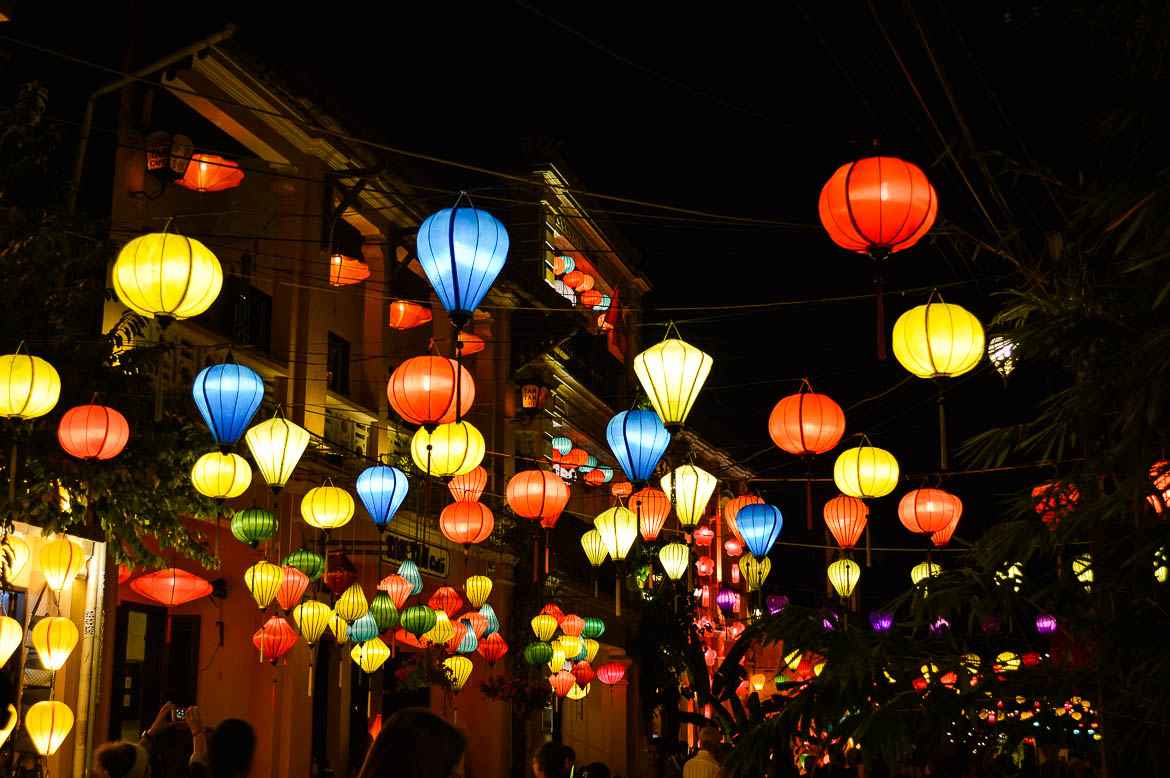
Where to Eat in Hoi An
In addition to the great stops offered on the Vespa Adventures tour and noted above, many other memorable dining experiences await you in Hoi An. In my five day stay I fell pretty hard for:
Bale Well Restaurant, known amongst both travellers and locals as having an incredibly tasty and well priced set menu. For as little as 80-100k VND per person, you’re treated to an all-you-can-eat feast of Bánh Xèo, shrimp spring rolls, various grilled pork, and pork satays all for making your own spring rolls with, not to mention a mango dessert. Part of the iconic dining experience at Bale Well involves the owner and cook demonstrating how to assemble the ingredients together into the perfect spring roll. She’s also known to literally hand feed guests who look like they need the help. The open air restaurant, is, as most great things in Vietnam, located down a rather dodgy looking and hard to find alley. The address is 45/51 Trần Hưng Đạo, just North of Phan Châu Trinh within the ancient town.
Mango Mango and sister restaurant Mango Rooms are both run by Vietnamese-American celebrity chef Tran Duc. Though quite pricey, the riverside patios are great for people watching and the ultra fresh Vietnamese fusion cuisine certainly impresses. Mango Mango is on the South side of the Thu Bồn River at 45 Nguyễn Phúc Chu while its counterpart is on the North side at 111 Nguyễn Thái Học. Reservations are a good idea for either if you want prime seating during dinner.
Hoi An Roastery. Inevitably, you’ll need to take an afternoon break and refuel before facing the crowds that descend upon Hoi An’s ancient town at sunset. With three locations in town, Hoi An Roastery serves up delicious fairly sourced Dalat coffee, strong wifi, and freshly baked goods. If amazing coffee isn’t enough, the rustic and charming CocoBox is a cafe, juice bar and farm shop all in one. The chill two story hang out is home to a variety of local organic Vietnamese food and health and beauty products, including homemade truffles. CocoBox is at 94 Le Loi, in the heart of the ancient town.
Nomad Cafe, affiliated with Nomad Yoga, has garnered the attention of yogis and foodies alike. The vegetarian cafe has a menu of East Asian and Mediterranean dishes that rotates weekly. Healthy breakfast smoothies are packed full of nutrients, not to mention colour and taste. Nomad Cafe is located at 6 Le Hong Phong, which is a 15 minute bike ride North of the ancient town.
Reaching Out Teahouse is, perhaps, my absolute favourite dining experience in Hoi An. This centrally located traditional teahouse offers so much more than tea, coffee, and cookies. It employs persons with disabilities (PWD) as servers and craftspeople at the affiliated artisan workshop. The latter of which produces stunning china sets, serving pieces, jewelry, and home decor as well as offers free tours of the workshop. Travellers are encouraged to enjoy tea in a beautiful cozy garden in silence (as many servers are either hearing or speech impaired), and they employ a unique written menu system to facilitate this. The peacefulness of this venue is without parallel, much like the delicious tea and cookies. A genuine must on the list of places to visit while in Hoi An. The teahouse address is 131 Tran Phu Street. Hours of operation are 8:30am – 9pm Mon-Friday and 10am – 8:30pm on weekends. The workshop and artisan store is located nearby at 103 Nguyen Thai Hoc Street.
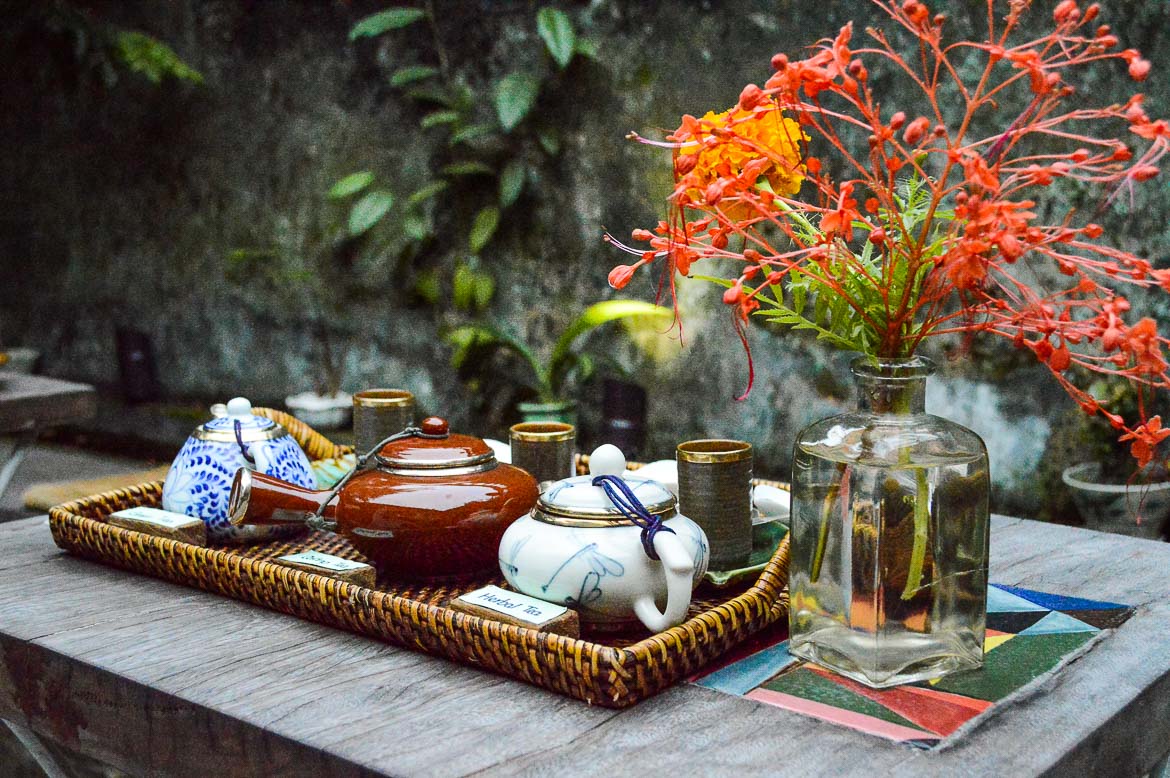
More About Vespa Adventures
2017 marks the ten year anniversary of Vespa Adventures. What first began as a tour company in Saigon has spread to include interesting food, adventure, and multi day tours in Hue, Hoi An, Hanoi, and even crossed borders into Phnom Penh and Siem Reap. The concept is simple: provide travellers with confidence of a knowledgeable safe driver, while showing them the unique aspects of the city they are visiting, often well off the regular tourist track. Group sizes are kept small, which I’m a big fan of. Of course, a passion for restored vintage Vespa scooters is also woven into the operation. Many of the Vespa’s in use are over 40 years old, but don’t worry they are serviced regularly – we asked.
The Departful team has taken the night food tours in both Saigon and Hoi An and enjoyed every minute of these stomach stuffing adventures. The beer lover in us is also impressed to see they have just added a Saigon Craft Beer Tour to the roster.
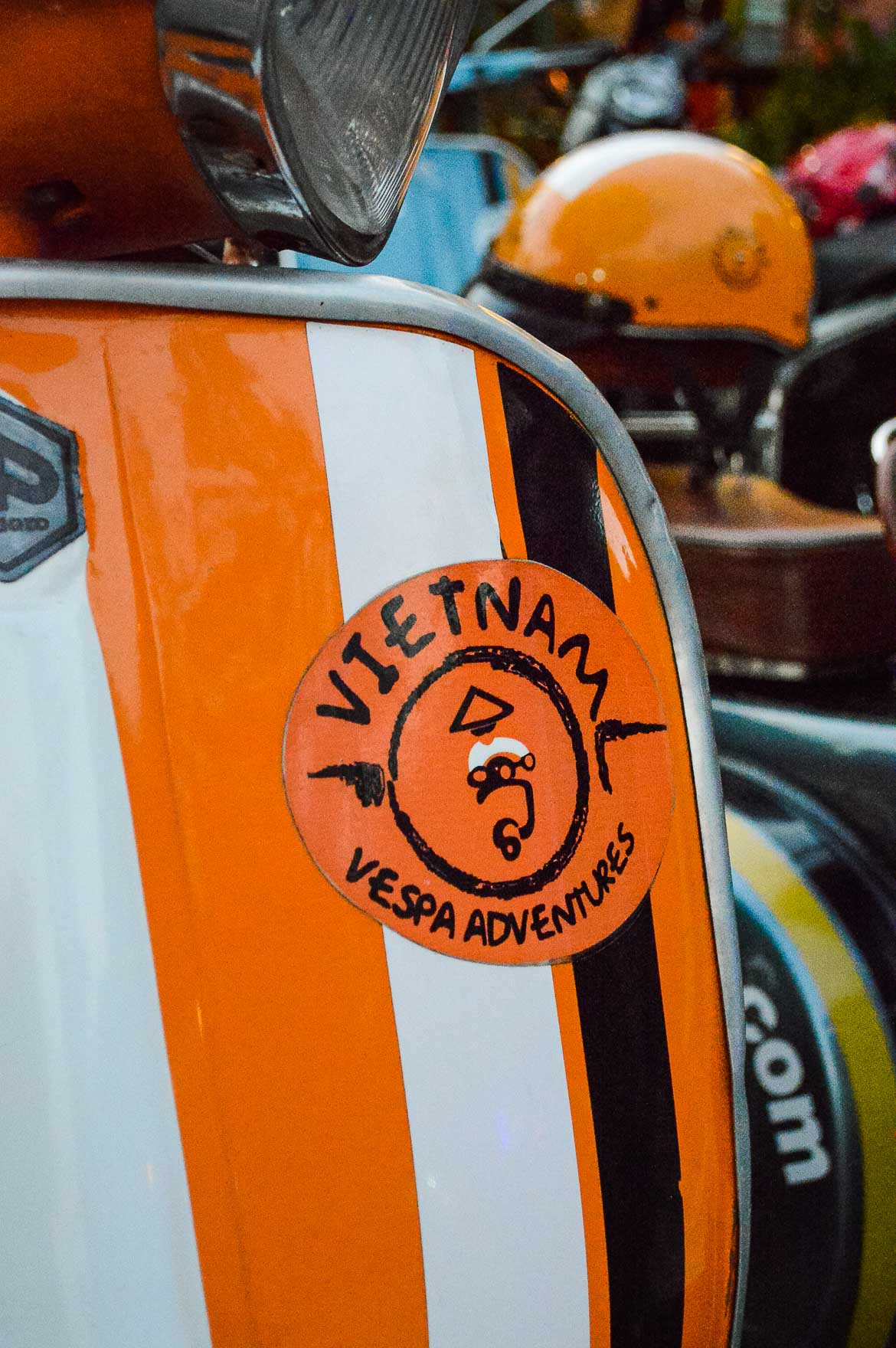
Disclosure, although I was a guest of Vespa Adventures’s Hoi An Food Tour, the opinions expressed in this article are entirely our own.
Hoi An Food Tour photos courtesy of Madeline Burch.
Make your next trip the best one.
Departful is a full service travel agency creating truly exceptional travel experiences that are 100% personalized to you. Wherever you’re going, whatever your interests, we help you plan the perfect trip.
Madeline Burch
Madeline was born and raised in Toronto Canada, educated in marketing, and has worked in brand management and the alcohol industry for nearly a decade. In search of great drinks, stories and photos, she has travelled to South East Asia multiple times including a recent eight month stint based in Vietnam. From luxe travel to volunteer missions, she’s interested in it all.


